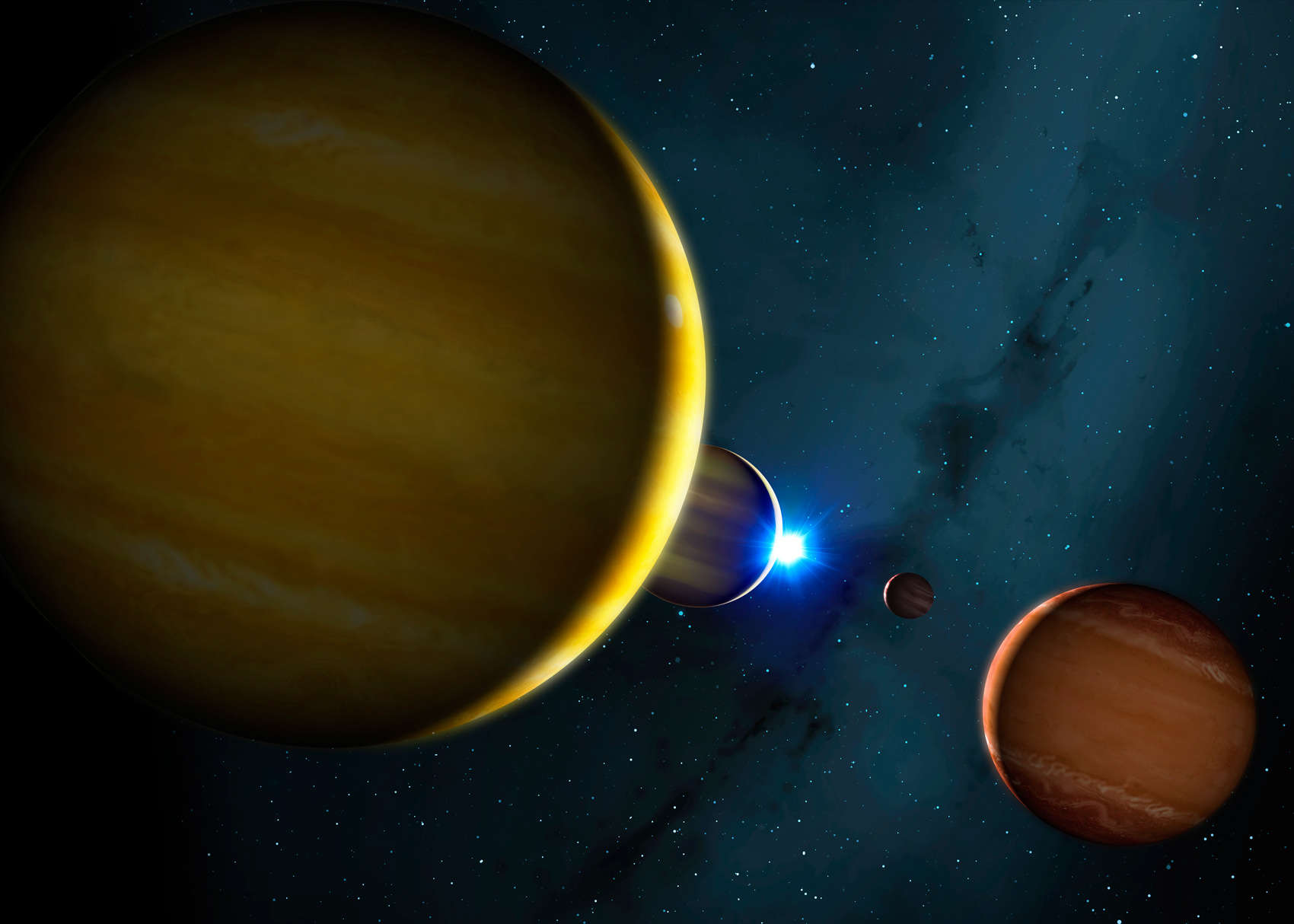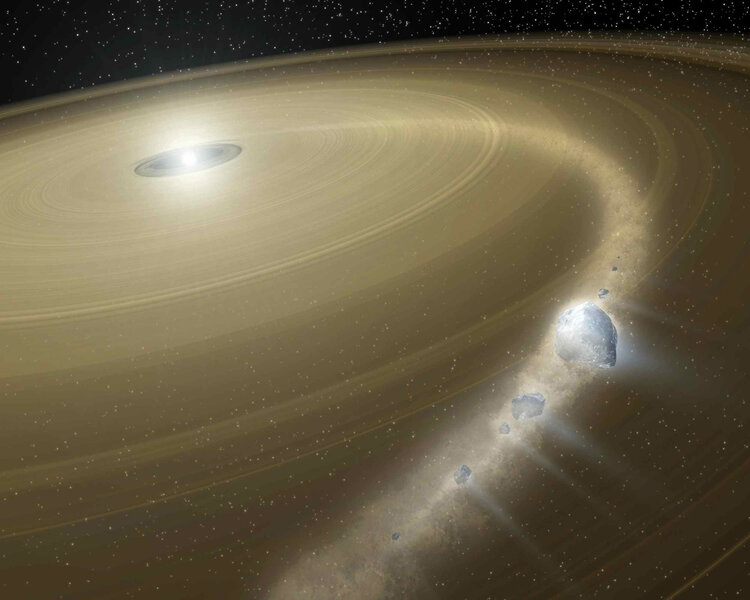Create a free profile to get unlimited access to exclusive videos, sweepstakes, and more!
The ultimate fate of a nearby four-planet system: cosmic pinball, then game over

Bad news: Any potential aliens that live in the HR 8799 planetary system have only about 3 billion years to learn how to build starships before their planets are ejected into interstellar space when the star dies.
Good news: The planets are only 30-40 million years old so there are no aliens there anyway.
¯\_(ツ)_/¯
HR 8799 is a young nearby star, just 135 light years from Earth. The star is about 1.5 times the Sun's mass, making it brighter and hotter than the Sun. It's likely part of a small, loose cluster of stars called the Columba Association, known to be around 40 million years old.
In 2008 three massive planets were discovered orbiting around the star, and a fourth found in 2010. Incredibly, all four were directly imaged, meaning seen directly in telescopic images! In fact, over the years, all four planets can be seen to move in their orbits around the star one of the most amazing videos I have ever seen:
Whoa.
Going out from the star, the planets are named HR 8799 e, d, c, and b (they are designated in order of discovery, not distance; e was the last one found) and are at distances of 2.2, 3.6, 5.7, and 10 billion kilometers from the star. Their orbital periods are very roughly 45, 100, 190, and 460 Earth years.
That's interesting: It puts them in what's called a resonance, where the orbital periods are simple integer ratios of one another; specifically 1:2:4:8. Resonances happen pretty often in multiple-object systems, and can help keep the system stable. If one planet gets pulled ahead in its orbit by another planet, a third planet will pull it back, maintaining the resonance.
However, this resonance won't last forever. In a newly published paper, astronomers used models of how planets orbit their star — including the affects of their own gravity as well as those from passing stars and even the tides from the galaxy itself — to see how the system behaves over time.
What they found is that the resonance is likely to persist over what's called the main sequence lifetime of the star, when it's calmly fusing hydrogen into helium in its core, as the Sun does now. However, the star is more massive than the Sun, and goes through its fuel faster. Unlike the Sun's 10+ billion-year lifetime, HR 8799 will run out of fuel in about 3 billion years. When it does it will swell up into a red giant and start blowing a wind of particles, shedding its outer layers. That's the beginning of the end.
In a relatively short amount of time it will lose about half its mass. That means its gravity will get weaker over time, so the planets won't be held on as tightly. They'll start to move outwards, breaking the resonance. After that, well, all hell breaks loose.
The models don't give any one answer to what happens next; instead the initial conditions (current mass of the star, the planets, their distances, and so on) are changed very slightly for each model run in the computer to see what happens given the fact that we don't know those conditions exactly. What the astronomers found is that almost certainly, chaos results. The thing is they don't know what chaos exactly.
Most models show that a pair of planets interact and get ejected from the star completely, sent out into interstellar space to wander the galaxy. Sometimes the planets collide. Sometimes they fall into the star. In one simulation run planets b and e swapped positions while c and d were ejected. In another, a star passes by HR 8799 around 144 million years from now, and while it doesn't disrupt the system it changes it enough that when HR 8799 swells up planet c is ejected.
Basically, no matter what, things get bad. But there's more.
The star has two debris disks orbiting it, belts of material likely to be similar to our asteroid belt. One is inside the orbit of planet e, about 1–2 billion kilometers from the star, and the other starts around 13 billion kilometers out and may extend to 45 billion.
In the simulations, as the planets move around, the disks get massively disrupted. Material will get flung both away from and toward the dying star. And we may have seen the results from such a thing before...
Once the star loses its outer layers, all that will be left of it is its tiny, dense, and searing hot core that is now called a white dwarf. We know that many white dwarfs have or once had planetary systems; some show evidence of eating asteroids around them — we see heavy elements like calcium and iron in their spectra, when a lone white dwarf should only show hydrogen and helium. Heavy elements sink quickly beneath the surface, so any white dwarf with heavy elements on its surface must have recently eaten its children.
In fact, most white dwarfs like these that we know of come from stars like HR 8799 that are more massive than the Sun. From the models, it looks like HR 8799 will join that group. Asteroids and other debris will fall into the white dwarf, polluting it with heavy elements that could be detected from other stars.
So while all this news sucks for those planets, it's rather good news for astronomers here on Earth. HR 8799 is young, and by studying it now we can learn more about the very old white dwarfs we see that have cannibalized their own systems. The models used to predict their behavior can be tweaked based on what we've learned here so we understand them better.
I'll note too that while the planets of HR 8799 are farther apart and more massive than our own, the Sun will one day become a red giant and then a white dwarf as well. Studying HR 8799 is like looking into a crystal ball and seeing our own potential future. Astronomers have already been looking into that — the results aren't pretty — but it's worth knowing. At that point the Earth will have been consumed by the Sun, so hopefully at that point humanity (or whatever we've evolved into) will be looking at it from a younger, new planet... if we even need them by then.



























